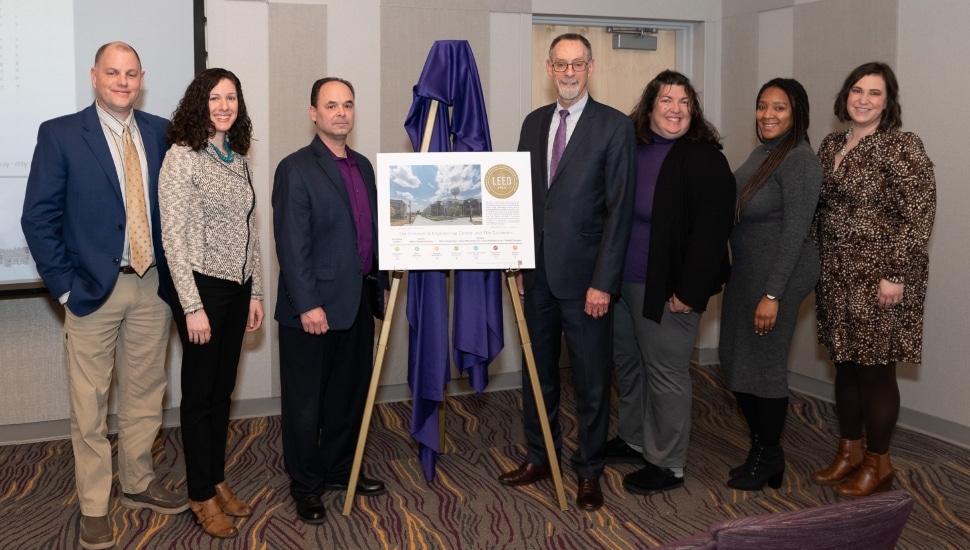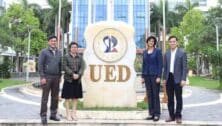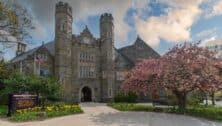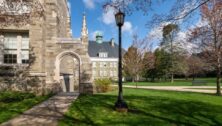U.S. Green Building Council Awards LEED Gold Certification to WCU’s Sciences & Engineering Center and The Commons

West Chester University’s 175,000-square-foot Sciences & Engineering Center and The Commons (SECC) turned solid gold this month with the news of its LEED (Leadership in Energy and Environmental Design) Gold certification from the U.S. Green Building Council, based in Washington, D.C. The coveted award was recently announced during a meeting of the university’s Sustainability Council, which drew faculty, staff, students, and project participants to the newest and most complex building in the University’s history to celebrate the achievement.
West Chester University President Chris Fiorentino, Vice President for Finance and Administration Todd Murphy, Senior Associate Vice President of Facilities Dave McNamara, and Sustainability Council Chair and Associate Professor of Sociology Aliza Richman presided over a campus ceremony to unveil a replica of the plaque that the U.S. Green Building Council will soon send to the university to install in the SECC.
“The SECC is more than a building; it’s a symbol of our dedication to a greener future,” said Fiorentino. “This LEED Gold certification, intentionally sought and achieved, epitomizes our commitment to sustainability, which is central to our strategic plan. From the green roof to the innovative use of HVAC system condensation for irrigation, the SECC demonstrates an exceptional level of commitment and ingenuity.”
As the newest building on campus, the three-story facility is home to the university’s rapidly growing health science curricula, physics, biomedical engineering program, and expansive academic and support spaces. Recognizing that meaningful connections happen in various settings, the facility also features The Commons — a welcoming and stimulating environment for students to gather, eat, and work.
Several university employees were singled out during the ceremony for their leadership and significant contributions to the project’s success, including Campus Architect Kathy DiJoseph, former Associate Vice President Gary Bixby, and Campus Interior Designers Tiffany Bailey and Kathleen Sotolotto.
“Their collective efforts have been instrumental in the sustainable construction of the SECC and in integrating these broader environmental advancements into our campus infrastructure,” said Murphy of the visionary team. “This project, with its high-tech sustainable features and economic benefits, underscores our university’s resolve to uphold environmental responsibility. It aligns with our strategic goal of reducing operational costs while contributing positively to our environment.”
McNamara stressed the university’s commitment to continue its pursuit of the gold. “WCU’s strategic guidelines dictate that any new construction is built to LEED Gold specifications,” he said. “This is a testament to our university’s foresight and commitment to sustainable development. The SECC, with its state-of-the-art features and environmentally friendly design, sets a new benchmark for campus construction.”
Representing more than 250 faculty, students, and staff, the Sustainability Council was especially proud of the accomplishment and its significance. “The SECC highlights the collaborative nature of sustainable advancement at WCU, with the Sustainability Council’s committees working in conjunction with the Office of Sustainability, the Facilities Division, and key administrators,” said Richman. “The SECC showcases our commitment to reducing our environmental footprint, educating our community about sustainable practices, and sets the standard for future campus construction to reach LEED Gold or Platinum certification.”
The SECC is the second building on campus to be awarded LEED Gold certification. The university’s College of Business and Public Management was the first building on campus to be designated as LEED Gold. Swope Music Building and Mitchell Hall are both LEED Silver. In addition, the 25 University Avenue building and the Student Recreation Center both meet LEED standards.
Sustainability Efforts Are Natural Practices on WCU’s Campus
Environmental, economic, and social sustainability are core principles that West Chester University’s community of educators applies to its teaching. Recognizing the university’s efforts, the U.S. Department of Education selected WCU as a 2023 U.S. Department of Education Green Ribbon Schools (ED-GRS) Postsecondary Sustainability Awardee. The University excelled in the three focus areas promoted by the ED-GRS initiative: reducing environmental impacts, improving health and wellness, and offering effective environmental and sustainability education.
WCU has been intentional about sustainability from its first Association for the Advancement of Sustainability in Higher Education (AASHE) with Sustainability Tracking, Assessment & Rating System (STARS) submission in 2017 to its investment in geothermal heating/cooling technology and energy efficiencies in campus buildings.
In fact, WCU has one of the largest geo-exchange heating and cooling systems on a North American college or university campus. In the first decade of the 2000s, as an aging steam heating system on campus required costly upgrades or replacement, the WCU Facilities Division, the Office of Administration and Finance, and senior leaders studied the options and made a commitment to a cleaner and more energy efficient alternative: geo-exchange heating and cooling technology.
WCU’s commitment to geothermal heating and cooling has led to the construction of a large, state-of-the-art geothermal pumphouse, a network of piping from the pumphouse to 12 academic buildings on the north campus, the drilling of over 800 boreholes in six well fields, and investment in heat exchange equipment to warm building space in the winter and cool it in the summer months.
The investment permitted the university to decommission coal- and heating oil-fired boiler plant, demolish the building, and use the land to construct the university’s new LEED Gold-rated SECC. With the decommissioning of the boiler plant, WCU eliminated more than 180 tons of air pollutant emissions every year from the building’s smokestack. This shift from a distributed steam heating system to a district geo-exchange heating and cooling system (along with several independent systems for Tanglewood, 25 University, and the E.O. Bull Center) contributed to an exceptional 28 percent decrease in WCU’s total greenhouse gas emissions (as measured in Metric Tons of Carbon Dioxide Equivalents, or MTCO2E) between the baseline years of 2010 and 2022. Per person, emissions decreased by 37 percent.
Among the many other examples of successful sustainability initiatives on campus are the university’s four organic gardens; its use of solar arrays on the roof of the Student Recreation Center and onsite at the Office of Sustainability; green roofs located at the FHG Library and the SECC; a green wall at the Student Recreation Center; as well as the Robert B. Gordon Natural Area for Environmental Studies (GNA), one of the oldest local forest habitats which was dedicated as a protected area in 1973.
Learn more about West Chester University (WCU), the largest member of Pennsylvania’s State System of Higher Education, and how it offers a comprehensive public institution with a diverse range of more than 180 academic opportunities in 40 fields of study across undergraduate, graduate, and doctoral levels.
Connect With Your Community
Subscribe to stay informed!
"*" indicates required fields












![95000-1023_ACJ_BannerAd[1]](https://vista.today/wp-content/uploads/2023/03/95000-1023_ACJ_BannerAd1.jpg)




































